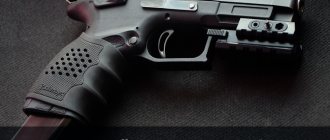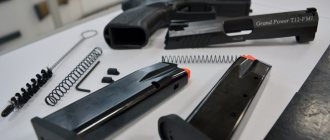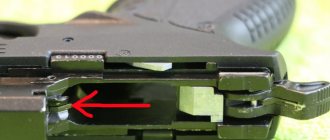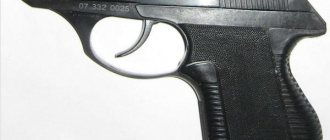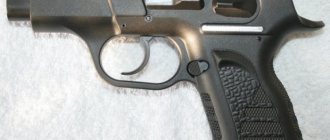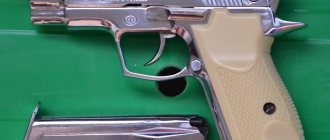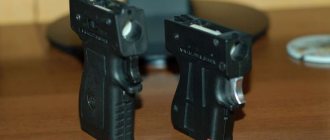The domestically produced traumatic pistol Grand Power t12 is classified as a firearm with limited destruction. Despite the fact that it cannot be called a full-fledged weapon in the traditional sense, this pistol can become indispensable if you need protection from intruders.
Contrary to the popular belief that traumatic pistols do not pose a serious danger and are unlikely to help save lives, the Grand Power t12 model has sufficient power and lethal force. During testing of the pistol, it turned out that at close range a bullet fired from the Grand Power t12 could pierce a car door or a thick book. There is no need to explain that it can be very useful as a means of self-defense. However, if you are in doubt about purchasing a firearm of this model, we suggest that you familiarize yourself with the technical characteristics and features of the pistol given in this article.
Development history of Grand Power T12
The Slovak company Grandpower, ltd, well-known among fans of military themes. , loudly declared itself in Russia, converting its K100 combat pistol into a traumatic one, and for a long time taking a leading position in the niche of weapons for self-defense. So, in 2008, the T10 model appeared, imported to Russia under the auspices of PKP AKBS LLC.
But competition does not stand still and, after a couple of years, the most discerning buyers can no longer unambiguously answer the question of “which traumatic pistol is the best” due to the general development of the industry as a whole and the products of individual companies in particular. It was during this period of time that the leading engineer and head of his own company, Yaroslav Kuratsina, took on the development of the next model, designed to consolidate all the strengths of his own design and correct “childhood diseases”. “Trauma” receives the index T12.
Grand Power T12. Here you can see in detail the fuse and magazine latches.
Manufacturers
In 2011, legislation in Russia changed and the import of foreign traumatic weapons was prohibited. The establishment of production at the AKBS plant has begun. The quality of the weapons dropped sharply and it took two years to improve them.
After 2013, trauma equipment regained its popularity, but in 2015, AKBS went bankrupt, and production was transferred to the Degtyarev and Fortuna LLC factories. The quality of weapons has dropped again. Pistol barrels burst en masse, this happened even when using low-power ammunition. The T12's reputation has again suffered sharply. The manufacturer managed to rehabilitate itself after about a year.
Description of design and principle of operation
The first thing the shooter feels when he takes this pistol in his hand is high-quality plastic, light and pleasant to the touch. The use of modern materials does not end there; for example, the shutter is made from an alloy of chromium, nickel and molybdenum, which undergoes a series of hardening and chemical treatment procedures. The barrel, trigger mechanism, bolt casing and frame are made of high-quality metal and are additionally protected with an anti-corrosion coating.
The trigger in the Grand Power T12 is standard: trigger type and double action. The twisted mainspring is located on the trigger and is made of especially strong steel, which is called “spring” among experts. Compared to the previous model, the fixation of the safety lever has been changed for the better: now it cannot operate independently when firing, even in a state of severe wear, which happened with the T10.
Grand Power T12 is unique among all other traumatic pistols due to its barrel design, devoid of pins and partitions. Instead, the smooth barrel tapers smoothly, eliminating the possibility of firing live ammunition. Because of this technical solution, according to current legislation, the T12 is classified as a “limited-kill firearm.”
The Picatinny rail on the lower front surface of the frame allows you to install a compact flashlight or laser designator - it all depends on the needs and budget of the shooter.
The safety is designed to be extremely convenient: you can bring the weapon into a state of combat readiness with one movement of your thumb by sliding the lever down. In the event of an unexpected danger for the owner of the Grand Power, and it is for such situations that traumatic weapons are purchased, it is not at all difficult for a trained shooter to remove the T12 from the holster and at the same moment remove it from the safety. For the convenience of any user, the safety levers are located on both sides.
17 rounds – that’s exactly how much it fits in the magazine – is enough for self-defense even against several opponents. The magazine itself is box-type, with a double-row arrangement of cartridges that line up in one row when firing. The latch is located at the base of the trigger guard.
Another important difference from the Grand Power T10 is the removable front sight. Many of those who use such weapons prefer to replace the standard front sight with a front sight with a fiber optic rod or luminescent mark, which greatly simplifies shooting in the dark or in bad weather conditions.
GrandPower T12
We have already talked on the pages of our magazine about the Slovak Grand Power T10 pistol, which at one time became a real breakthrough in the development of traumatic weapons (for more details, see RIGUE 6'2008). This model remained a leader in the self-defense weapons market for a long time. This time we got our hands on a direct relative of that same pistol - the GP T12. How is it different from its predecessor? Are these differences worth buying a new pistol? How does the T12 compare to other models? We will try to answer these questions.
A few words about the parent
T10 was waiting. We waited a long time. We waited a lot. Throughout 2007, hundreds of people, rushing home from work and eating dinner in a health-threatening hurry, flocked to the guns.ru online weapons forum and shared with each other their vision of what the Ideal Traumatic Pistol should be. These visions were accumulated over the course of a year by the chief designer and owner of the Slovak company Grand Power, Jaroslav Kuracina. Having presented to the public a prototype of a new traumatic pistol based on his own K100 model, Yaroslav listened to all the wishes of future consumers, the most adequate and realistic of which were embodied in the prototype. The approach for the domestic consumer of “trauma” was unexpectedly pleasant. It has never happened before that gun manufacturers take into account the wishes of future buyers. Therefore, the T10 has become the most anticipated new product on the self-defense weapons market. Grand Power's partner in Russia is PKP AKBS LLC, one of the most progressive companies in the market of self-defense weapons and ammunition for them. The conceptual discussion of the future pistol with the participants, its testing, certification and import into Russia took almost a year. In January 2008, the first batch of pistols was finally distributed to the lucky owners.
Perhaps we should recall the background against which the new product was so contrasting. The self-defense weapons market of that time was filled with continuous compromises. One pistol is quite effective, but only holds four rounds, and it looks... specific. The other one looks just like the real thing, only it’s made of light alloy and tears it apart at the seams after 50 shots. The third is made of “real weapon steel”, even a little similar to the PM (from afar, in the dark), only you need to buy a file for it in order to further give it the shape of a pistol and ensure the mobility of the bolt and the functionality of the trigger. And under no circumstances should you load powerful cartridges into it - the barrel may become inflated. The fourth pistol is good for everyone - it is made of steel, and its construction is strong, but there are such protrusions in the barrel that neither acceptable muzzle energy nor any accuracy can be seen.
Against the backdrop of such competition, the Grand Power T10 pistol became, dare I say it, a real breakthrough. It was the first powerful, accurate, durable and high-quality pistol, thought out in every detail. When it came to the editorial office for testing, I fell in love with it after the first day of use.
Below are a brief summary of all the advantages and disadvantages of the T10 pistol, identified during testing in 2008, described in detail in the above-mentioned issue of the magazine.
Let's start with the advantages:
- Durable steel construction. All parts of the pistol (except for the plastic handle) are made of high quality steel. It is in principle impossible to damage the T10 structure with a powerful cartridge. After 2,000 rounds fired from the test sample, no wear was detected.
- Efficiency. The T10 demonstrated the best muzzle energy and accuracy of fire at that time.
- Magazine capacity. The pistol magazine is designed by the manufacturer to hold 10 rounds. But it could potentially hold up to 17 rounds, which in the case of a “gas weapon” (which is what the T10 is certified to be) is not a violation. The set includes two such magazines.
- Ergonomics. The shape and angle of the handle ensured extremely comfortable shooting.
- Convenience and thoughtfulness. Notches on the front of the slide, ambidextrous safety, slide stop and magazine release. Every little detail has been worked out in the pistol.
During the operation of the pistol, certain shortcomings were also identified. There are only two of them. The first is directly related to the cartridge used - 10x22. Its short and thick cartridge case made the tolerances of the technical parameters that ensured reliable reloading of the pistol (recoil spring force, cartridge feed angle, magazine fixation height, gunpowder weight) extremely small. As a result, the slightest change in any parameters (for example, fluctuations in the weight of gunpowder in cartridges of different batches or a slight divergence of the magazine jaws, changing the feed angle of the cartridge) led to delays in firing. The manufacturer sought to eliminate this problem, and the T10 improved with each batch.
The shops were being refurbished. Initially, “native” magazines from the K-100 chambered for the 9x19 Luger cartridge were used. They were then equipped with a plastic insert designed to eliminate reloading problems caused by the difference in the length of the 9x19 and 10x22 cartridges. However, this did not completely solve the problem - some pistols were still unstable. Then the manufacturer abandoned the plastic insert and lengthened the magazine jaws, eliminating premature ejection of the cartridge, which causes sticking into the upper part of the chamber. In parallel, with each new batch, other elements of the pistol were refined - the chamber was polished, the ejector hook was rounded. All these changes, of course, reduced the number of problem pistols in each new batch, but did not completely eliminate the possibility of sticking. So some owners of pistols, even from the very latest batches of T10, had to contact a weapons workshop, a T10 tuning specialist who had already brought the unstable pistol to perfection.
The second problem with the T10 is the breakage of the plastic handle. Even when using standard cartridges, some pistols (according to statistics from one of the dealers of PKP AKBS LLC - 1 out of 50 sold) after 40-50 shots a crack appeared in the trigger area. This problem was eliminated simply because... This part has no number and can be replaced in 10 minutes. And even if the owner of a pistol had such a problem, neither the manufacturer nor the dealers ever refused to provide a new grip.
On my pistol, the delays began after 200-300 shots. About one or two per store. To eliminate this, the magazine was replaced with a more advanced one. Another 100-200 shots - and again the gun begins to upset me. The return spring is replaced. 300 shots - the same picture again. The magazine is replaced again - with a later version, with long jaws. In addition, the ejector hook was replaced (with a new one with a rounded shape). The delays disappeared after 150 shots, then reappeared. Now the dependence could be traced from the batch of cartridges - the time had come to “select” the batch for your pistol. In general, I was never able to achieve 100% reliable reloading operation.
It should be noted that not every T10 had such problems. The vast majority of pistols, especially from the latest batches, worked flawlessly. But there was a possibility that having bought a pistol, you would have to modify it. And people took this risk because... The T10 had no analogues in terms of characteristics.
But time passed, and more and more new models of self-defense weapons appeared. Some models have already begun to step on the heels of the T10 in terms of their characteristics, and some have completely surpassed them. For example, Groza pistols with a V4 barrel version, which, with comparable (and in some cases exceeding) muzzle energy, had more compact dimensions and significantly greater reliability than the T10. And then the Grand Power and AKBS companies responded with a new model - the Grand Power T12 pistol.
They started talking about the development of T12 almost immediately after the first batch of T10 entered the market. This pistol was supposed to be chambered for a fundamentally new cartridge, exceeding in efficiency the existing small-caliber 9 mm RA cartridges. and 10x22. In addition, the pistol had to correct all the shortcomings of its predecessor.
New cartridge 10x28
When creating the T12, manufacturers did not adapt to the not very successful 10x22 cartridge. Especially for the new pistol, the AKBS company created a fundamentally new 10x28 cartridge. As is clear from the markings, the diameter of the sleeve is 10 mm, its length is 28 mm. What's so innovative about the new cartridge?
First of all, the bullet. As is known, the effectiveness of a traumatic cartridge is determined by the speed and mass of the projectile. A projectile with greater mass at the same speed will have a more effective stopping effect than a lighter one. Also an important characteristic of a traumatic projectile is the area of the bullet upon contact with the target: the larger the area (with equal mass), the less penetrating ability of the bullet, and therefore, the lower the likelihood of damaging internal organs and arteries. Those. a traumatic bullet aimed at stopping without causing serious injury must have as large an area and mass as possible.
The diameter of the rubber bullet of the most common cartridge is 9 mm R.A. – 10mm. Its average weight is 0.7g. The bullet weight of the most effective cartridge of this caliber today (which is produced by the same PKP AKBS LLC) is 1 g. For comparison, here are the characteristics of the new cartridge. Bullet diameter – 13 mm. The increased diameter made it possible to increase not only the muzzle energy, but also the mass of the bullet. The bullets of the latest batches of 10x28 cartridges are weighted with metal shavings and have a mass of 1.8 g.
The second important characteristic of a cartridge is the length of the cartridge case. It was not chosen by chance in the new caliber. The 10x28 cartridge corresponds in length to the 9x19 Luger combat cartridge, for which the T12 is designed. And this, in turn, allows you to avoid all the problems with reloading that arose in the T10 due to the short 10x22 cartridge. 10x28 is perhaps the most promising of the “traumatic” calibers today. The increased diameter and mass of the bullet allows the manufacturer (in case of legislative relaxations) to significantly increase the muzzle energy and efficiency of the ammunition. In addition, the new traumatic cartridge allows it to be adapted to many other pistols that were originally designed for the 9x19 Luger. Thus, it is an ideal basis for creating new models of traumatic weapons based on combat samples.
Inspecting T12
The T12 was the first pistol to use the new caliber. Outwardly, it is practically no different from its predecessor, but upon closer examination the differences become obvious.
But let's start with the similarities. The new pistol inherited almost all of its advantages from the T10, namely:
- absolutely reliable strength of steel elements
- ergonomics and balance
- bilateral controls
- highest quality surface treatment
- two magazines with high potential capacity
- adjustable rear sight
- fast recharge capability
- possibility of installing an under-barrel flashlight / laser pointer
There are also no white dots on the rear sight and front sight, but you can apply them yourself.
Now let's see how the new model differs from its predecessor.
The key difference is the barrel. The new design is designed to accommodate a new caliber and has noticeable differences. The T12 barrel is also made of steel, but has only one lug at the top, versus two lugs at the top and bottom of the T10 barrel. Immediately after the protrusion there is a smooth tube of increased diameter, designed for a larger bullet diameter. The muzzle of the new pistol has a completely different shape; visually the barrel seems thicker.
The pistol also received a new grip, MK7. Its main difference from the MK6 used in the T10 is the ability to install linings of various sizes on the back of the handle. Thus, you can adapt it to the size of your palm.
Another difference is increased strength. According to statistics from the same dealer (Gunshop of the Baltic Shooting Center, St. Petersburg), out of 600 T12s sold there was not a single case of a handle breaking. The third difference is a clearer fixation of the fuse than in the T10.
The next difference is the shops. The fact that a special cartridge was developed for the T12, repeating the shape of the 9x19 Luger cartridge, made it possible to use original magazines from the combat K100 in the new traumatic pistol, without any changes in the form of inserts and elongated jaws. This unification simplifies the search and acquisition of spare and training magazines. In addition, the use of original magazines solves all problems with feeding cartridges.
The return spring is strengthened because a more powerful cartridge is used. The front sight, unlike the early batches of the T10, is removable. This allows you to install optical fiber instead, which greatly facilitates aiming in low light.
All of the above can be attributed to the advantages of the new pistol, to its improvements. But it was not without its drawbacks. The first, quite significant one, is the absence of notches on the front of the bolt. The absence of these notches, together with a fairly strong return spring and the even shape of the bolt, greatly complicates the fastest way to chamber a cartridge by holding the bolt by the front. The latest batches of T10 had the same drawback - the shutters became smooth. This forces a certain category of owners of this pistol to stick sandpaper on the bolt or retrain for a different bolt grip. The second drawback is the modified shape of the trigger. A sharper trigger kills the lining of a jacket after just a couple of weeks of wearing it in an open holster. It should be noted that a trigger of this shape was installed on a limited batch of pistols, incl. the one that came to us for testing.
Let's shoot
The very first shot from the T12 made it clear that a much more serious caliber was being used. The hand, which had become accustomed to all the nuances of the T10’s behavior after a couple of thousand shots, was very surprised - the T12 had a semblance of recoil! No, it certainly doesn’t feel like a 9x19 Luger yet... but it’s no longer a “cracker” 9 R.A. or 10x22, the recoil of which is no stronger than that of a pneumatic with a recoil bolt.
During the tests, cartridges produced by PKP AKBS LLC, caliber 10x28, were used.
To begin with, we determined the accuracy of the pistol. We shot in series of 5 shots from 10 meters at standard IPSC targets. As practice has shown, the result directly depended on the batch of cartridges. The November batch of cartridges showed the best accuracy - the result was from 6 to 9 cm. Earlier batches (with red balls, already discontinued) showed the worst results - from 11 to 25 cm. If we take the average accuracy of good cartridges (7.5 cm by 10 meters) for the result, it is very pleasing. Do self-defense weapons require better accuracy? No. The T12's accuracy at self-defense ranges is 100% satisfying.
Just for fun, we shot a series at 20 meters - all the bullets hit the IPSC target. And she is smaller than the silhouette of a person. The difference in energy was tested on a test chipboard 1.8 cm thick, on which many models of self-defense weapons were fired. A T10 with a 10x22 Magnum cartridge pierced it right through from a distance of 1.5-2 meters. At 5 meters the bullet was already stuck, leaving a crater half the depth of the chipboard. We shoot at 5m from the T12 - right through. 10m – right through. 15m - almost right through, there is a through hole, but the bullet did not go through entirely. For comparison, most models of self-defense weapons, let’s not name them, when shot even from a distance of 1 meter, leave a depression of no more than 4 mm in the same test chipboard.
At the next stage, we checked the behavior of the T12 during tempo shooting - we built various exercises and performed them on a timer. Yes, if we compare the T12 with its predecessor, we can say that it is not at all as obedient as the T10, which does not leave the target at all when firing... The power of the caliber affects it. But compared to firearm calibers, it still remains many times more controllable and comfortable.
A few words about reliability
In total, about 300 rounds of ammunition were fired from the test sample, in several stages, with two cleanings. Not a single poke. This was not enough to make an objective assessment, so we turned to the same seller statistics. The AKBS company dealer, the gun store of the Baltic Shooting Center, sold 600 Grand Power T12 pistols wholesale and retail from September to January. To date there have been only four requests:
- two identical cases of sticking into the lower part of the chamber (both were eliminated by replacing the magazine latch);
- one case of trigger guard failure, in which the owner himself broke it with excessive force during disassembly;
- and the last case - the owner came to the store with a statement that he was “stuck in every cartridge.” When they took him to the shooting range and asked him to demonstrate, the reason for the sticking was established: the man was loading cartridges into the magazine with the back side, primer first. The cause was eliminated on the spot. There was no breakage of the handle. As a result, for 600 pistols there were only two problem units (with solvable problems), or 0.3%. This is an excellent result for a traumatic weapon.
Conclusion
In general, many owners of smooth-bore and rifled weapons, IPSC shooters and other people who regularly deal with firearms develop a rather lenient attitude towards “traumatics”. It is perceived as an inferior weapon, pampering. Traumatic pistols are disparagingly called “rubber spitters”, “chewing gum throwers” and other names designed to emphasize their frivolity and uselessness. This is caused by the low quality of traumatic pistols, their flimsy design, the ineffectiveness of many models, unreliability, lack of any acceptable accuracy, etc. But now this weapon is reaching a completely different level. T12 is the clearest example of this. Excellent accuracy, high muzzle energy, balance, controllability and multiple charges of this pistol enable a person with practical shooting skills to withstand an attack at self-defense distances no worse than using a firearm. By and large, T12 (again, if you have the skills) can be countered even with firearms at short distances (up to 10 meters). Of course, this possibility is purely hypothetical - it is unlikely that a civilian could be attacked with a firearm. Also, we are not talking about sudden attacks, in which a combat pistol would not help. But in many situations in which a firearm could help, the T12 can also help: the outcome of self-defense will depend more on skill than on the effectiveness of the weapon.
Grand Power T12 is no longer a rubber spitter. This is a weapon. It requires serious consideration, primarily from a safety point of view. The same as required by a gun or rifled carbine. Perhaps, based on the totality of its characteristics, it is the best traumatic pistol on the self-defense weapons market at the moment.
At the time when this material was being prepared for publication, the President of the Russian Federation, D.A. Medvedev, signed the text of amendments to the law “On Weapons”, which will come into force on July 1, 2011. These amendments, among other things, not only limit the muzzle energy of self-defense weapons (called “limited-kill firearms”) to 91 J, but also prohibit: “... foreign-made limited-kill firearms, their main parts, cannot be imported into the territory of the Russian Federation …" What does it mean? And the fact is that if the situation does not change, then such an effective weapon as the T12 will disappear from sale. I sincerely congratulate those lucky ones who managed to purchase this pistol and stock up on ammunition for it - from July 1, most likely, this will be impossible.
We can only hope that the leaders of the self-defense weapons market (the same as PKP AKBS LLC) will prepare a worthy response to the new law.
Dmitry Rogov
Grand Power T12 equipment
When purchasing from certified stores, you receive a small case containing:
- Gun;
- Two stores;
- Hex key;
- Cleaning brush;
- Replaceable front sight (or two, varies in different batches);
- Technical passport (user's manual).
In addition, while searching for material for this article, I found a number of sites selling additional accessories and parts for “tuning” both the T12 and other weapons.
There is no user manual in the photo, but the ammunition is visible
Ammo for Grand Power
The 10*22 mm ammunition used was the main weakness of the Grand Power T10. Despite its many strengths, it led to delays in firing after a hundred or two shots, and in advanced cases it jammed tightly, making the weapon useless.
Having listened to the feedback, Yaroslav Kuravitsa is developing a 10*28T cartridge for the T12, which has a number of features:
- Dimensions close to the standard pistol cartridge of Western countries - 9 * 19 mm, which simplified the work of future designers of traumatic weapons, because it is easiest to convert a combat prototype for this ammunition;
- The single power of the cartridge allows the owner to forget about the use of replaceable recoil springs, adapting to the ammunition. For example, 9 mm PA ammunition cannot boast of this;
- The rubber bullet, which expands in flight, has a fairly high stopping power, which makes the 10*28T cartridge one of the strongest in its class.
It was to unlock the full potential of this cartridge that the designers abandoned the typical “injury” partitions or pins in the barrel bore.
Pistol performance characteristics
Reviews from owners of Grand Power pistols released in the last two years of production are only laudatory. At a distance of 10 meters, the Grand Power T12 traumatic pistol shows excellent accuracy and accuracy, not inferior to firearms. It is believed that this is achieved by removing the teeth that blocked the bore.
To prevent firing of live ammunition, the barrel is narrowed on the chamber side. A review of practical shooting showed that accuracy depends mainly on the quality of the cartridges. 10x28 cartridges are available in several modifications with different energies. To ensure the automatic operation of the pistol, the manufacturer provides for the use of return springs of varying strengths.
Different pistols showed approximately the same results, which indicates the stability of production. The shooting was carried out in series of 5 shots. The distance chosen was 10 meters. The spread of hits ranged from 6 to 9 centimeters for different pistols. Tests at a distance of 20 meters showed that all bullets hit the target.
The penetrating effect of the bullet was tested on chipboard sheets 1.8 cm thick. Complete penetration was observed at distances of up to 10 meters. At distances of up to 15 meters, chipboard penetrated, but the bullet did not penetrate the barrier.
Weapon characteristics:
- dimensions 193x134x36 mm;
- weight 770 grams;
- accuracy 20 cm by 5 meters;
- power 90 J;
- magazine capacity 10 rounds;
- survivability 5 thousand shots.
There is a shelf under the barrel for attachments. You can install a laser sight or a tactical flashlight, or make a kind of tuning of the pistol. You will also need a holster to carry it.
Grand Power T12 has a double action trigger. A two-way lock is provided for disassembling the weapon. The trigger guard is designed as an integral part of the frame. The pistol is adapted for shooting from both the right and left hands. The magazine release buttons and slide stop levers are located on both sides, and the same applies to the safety levers.
Automation operates according to a blowback mechanism. The barrel has three external longitudinal grooves, which are made to limit the power of the cartridge. Before the ban in 2011, 10x28 cartridges had a power of up to 230 J. If desired, such cartridges can still be found.
The front and rear sights of open sights can be replaced with fiber optic sights that glow in the dark. The rear panels of the handle are made removable, which allows you to adjust their shape to the shooter’s palm.
Recently, Grand Power T12-fm pistols manufactured at , in which the barrel design has been changed, have appeared on sale. Now the injury has no narrowing or grooves, but has a tooth that prevents the firing of a live cartridge.
Specifications
Briefly about the dimensions of the new pistol:
| Length | 188 mm |
| Barrel length | 100 mm |
| Width | 36 mm |
| Height | 133.5 mm |
| Weight without cartridges | 770 g |
| Magazine capacity | 17 rounds |
The parameters of the initial velocity and energy of the bullet depend entirely on the brand of cartridges used, and sometimes even on the specific batch, and therefore are not given here.
This is what the accompanying documentation looks like
Assembling and disassembling the pistol
The procedure for partial disassembly for cleaning should be known to any shooter who is interested in ensuring that his weapon does not jam at the most inopportune moment, or for a simple modification such as replacing the recoil spring. To accommodate users, the Slovak company made this algorithm as simple as possible and somewhat reminiscent of disassembly.
So, the procedure is:
- Disconnect the magazine;
- Remove the weapon from the safety lock;
- Make sure the chamber is empty;
- Pulling back the trigger rod, move the bolt casing to the rearmost position and remove it from the guides;
- Remove the bolt casing from the barrel, moving it to the extreme forward position;
- Remove the return spring.
This simple sequence is enough for regular cleaning of weapons. Assembly occurs in reverse order.
